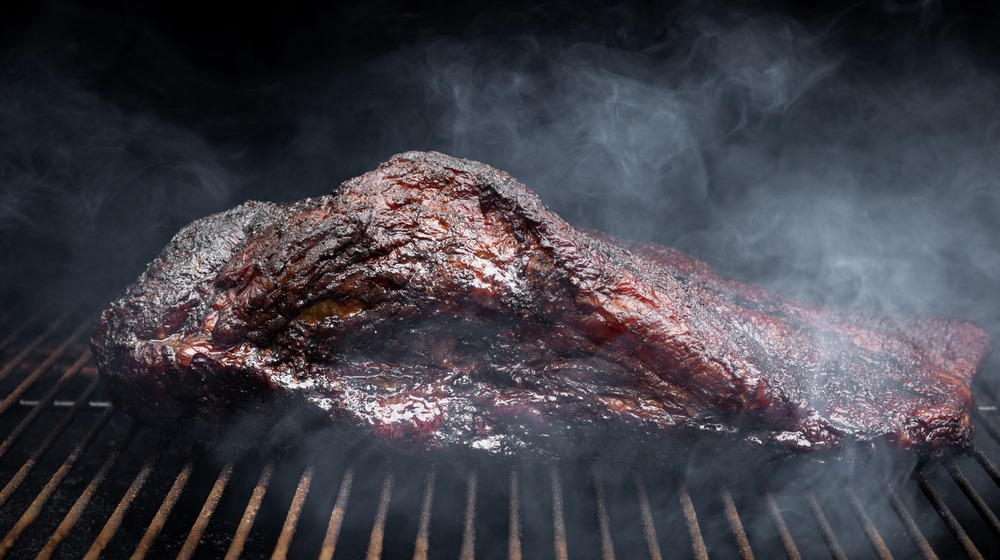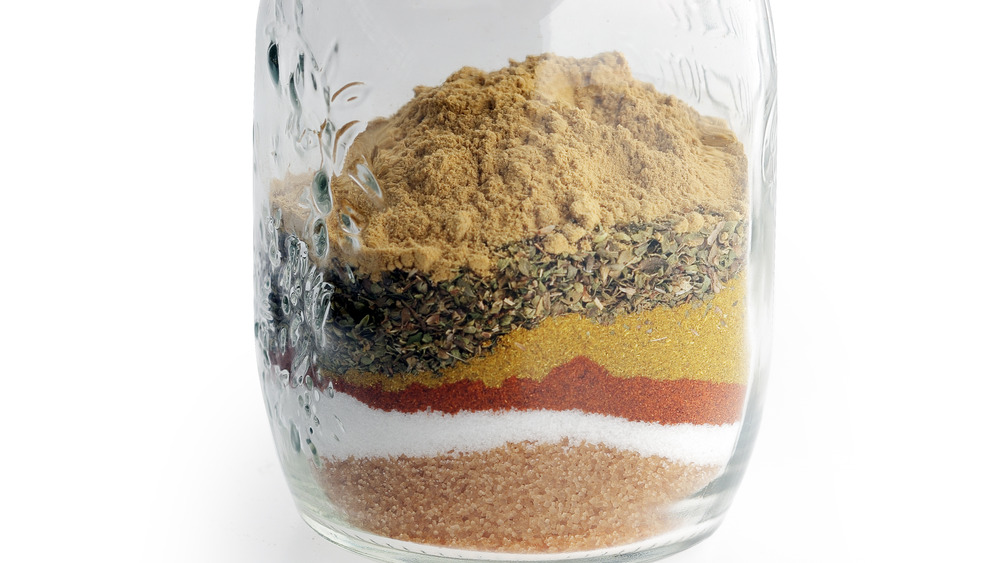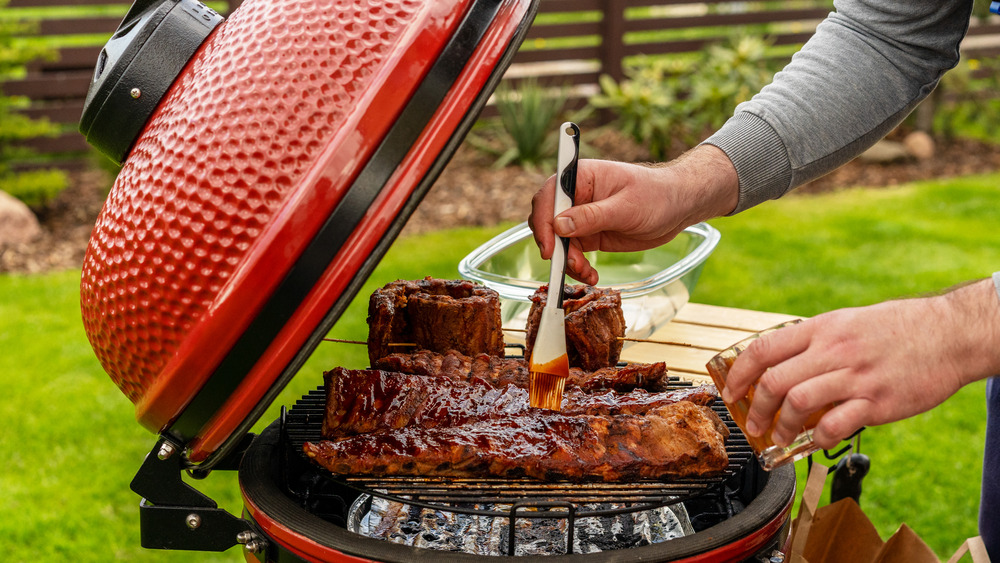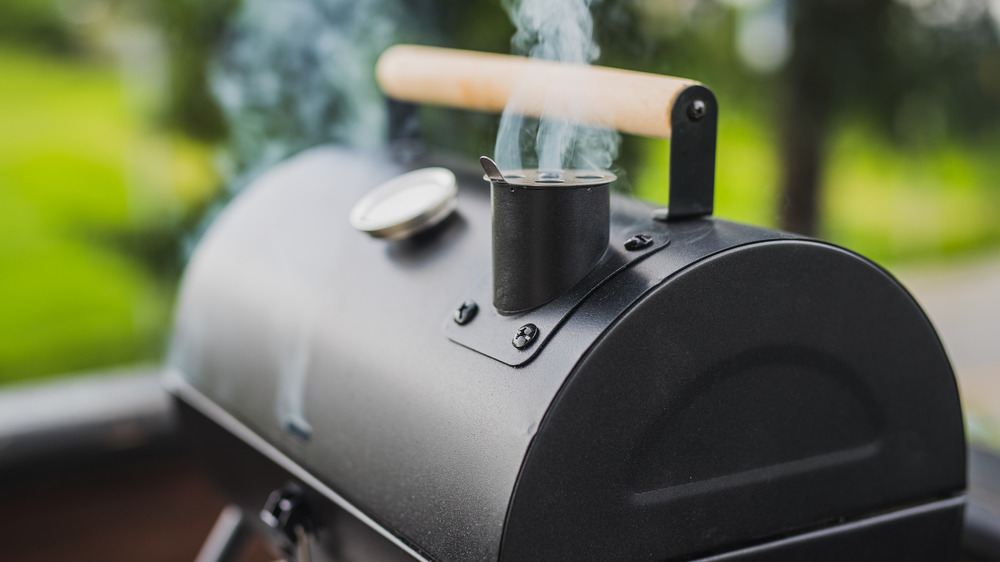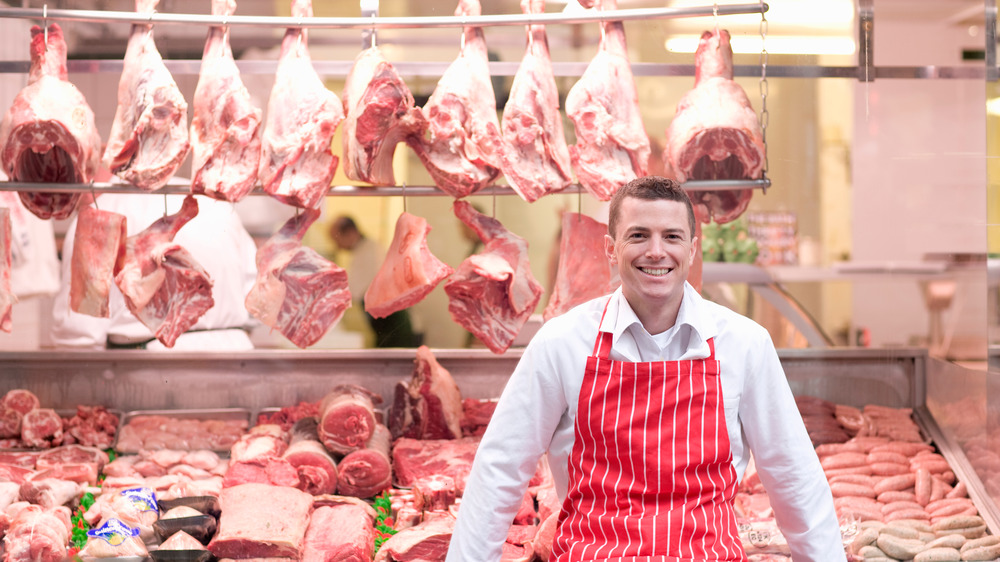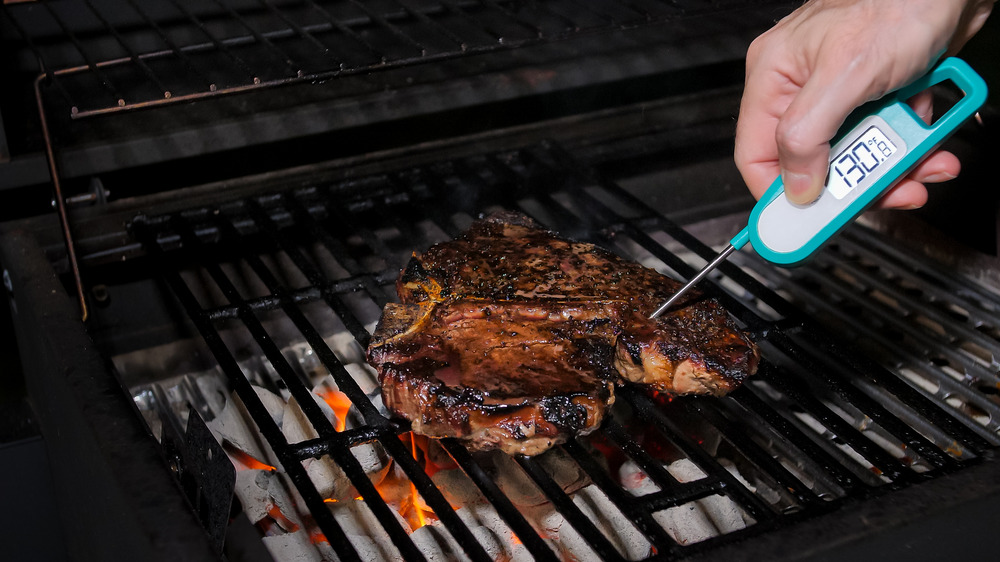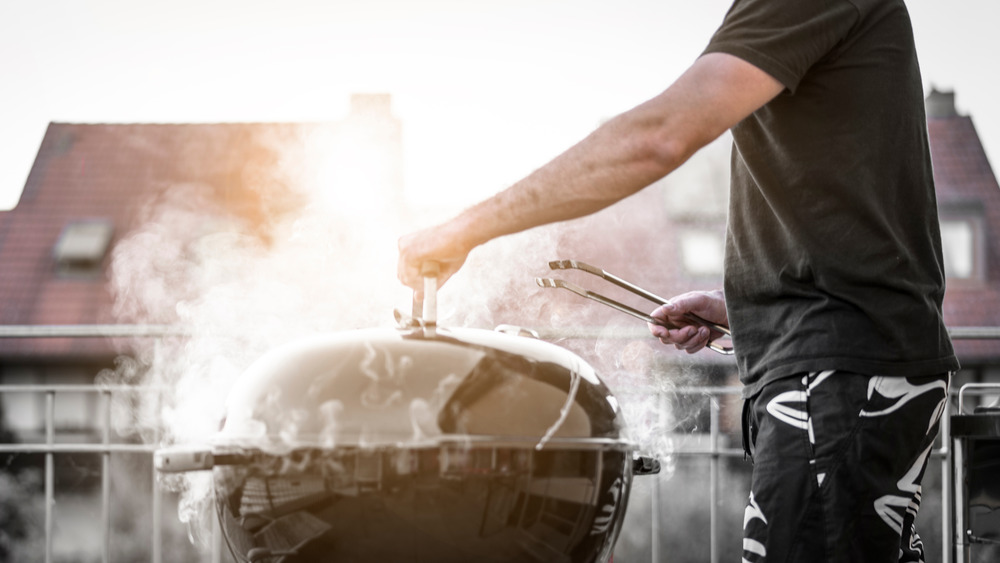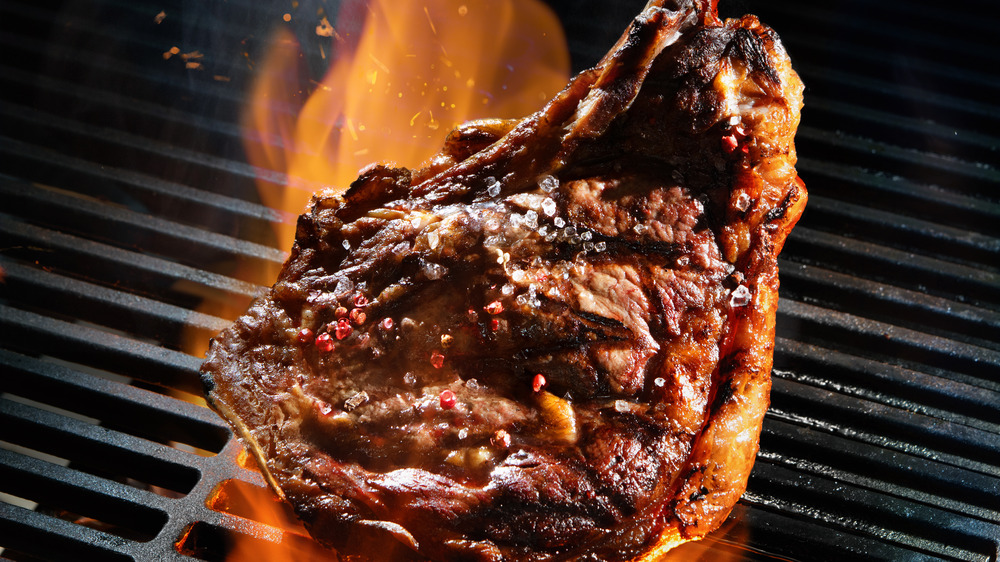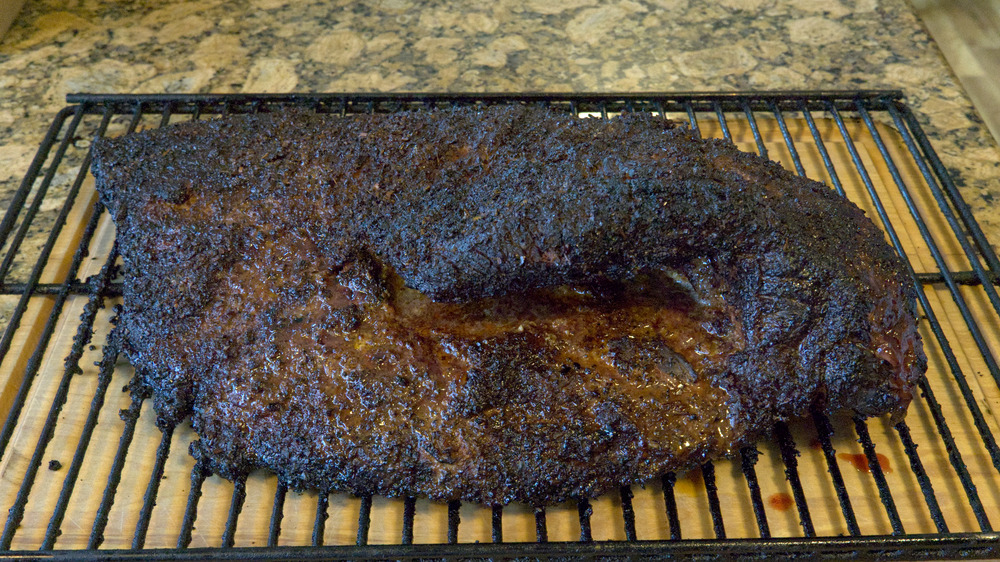How To Smoke Almost Any Type Of Meat
There's nothing quite like a fresh smoked brisket or pork butt. And whether you are smoking ribs or chicken, beef or pork, there's a whole lot to consider before getting started.
The art of smoking meats is definitely a labor of love, but it's considered that because the results are so worth the effort. A great smoking experience with delicious results takes time, temperature, technique and trial — trial quite possibly being the most important for the 4 T's, as there is no substitution for experience.
"Different in so many ways from more traditional cooking methods such as baking, braising or sous vide – smoked meats final product relies heavily on the 4 T's and then takes one more very important ingredient to bring it all together — the muscle," Rob Serritella, Head Pit Master at Holy Cow BBQ, told Mashed.
Each cut of meat is uniquely different — as different as the animal it came from. And once you figure out your method, you'll be set for all sorts of great smoked meat results. But first, here's how to smoke any type of meat, with tips from the experts themselves.
Seasoning and brine are key to flavor when smoking meat
Smoking meat is a long process, but if managed right, it can yield amazing results — but a lot of that can depend on seasoning. Whether you do a dry rub or a wet brine, the seasoning can impart serious flavor that's key to a great finish.
"Depending on what meat I'm smoking and the device I have to work with, my approach to prep will vary," Chef Hosea Rosenberg of Blackbelly and Santo restaurants in Boulder, Colorado, who also won Season 5 of Top Chef, told Mashed. "When smoking chicken, I'll use a wet brine. For pork, a dry rub." Beef can be simply seasoned, Rosenberg added.
Each cut requires a different preparation, so you don't want to use a one size fits all approach. If you're just starting out smoking, try simple ingredients, such as the ever-reliable salt and pepper, to season your meat. "Feel free to season liberally as these are large pieces of meat that can handle a lot of flavor!" Dana Murrell, Head of Culinary Development at HelloFresh, told Mashed.
As you get more experienced, start to change one variable at a time, such as a different seasoning or cook temperature, to hone in and create your perfect flavor. "At the end of the day, smoking is a very individualized process with lots of proven techniques. Regardless of technique or flavoring, smoking is a cooking process that almost always yields a wonderful result due to the long cooking times!" said Murrell.
Consider the environment when smoking meat
It may seem like the only aspects of smoking that matter are what is going on in the smoker. But what's around it matters too. The outside temperature or moisture can greatly affect the consistency of the burn in your smoker and cooking process. That's where the trial part comes in.
"Each smoker is different, and they all have a temperament," Rob Serritella, Head Pitmaster at Holy Cow BBQ in Los Angeles, said to Mashed.
You'll need to experiment more than once to get the perfect smoked rib, like the one you'll often find at your favorite BBQ joint. But remember that the pitmaster has spent countless hours perfecting his or her skills.
"They've seen wet wood, tough & fatty meat and unruly smokers that don't want to cooperate," said Serritella. "They've learned the tricks of the trade and I'm pretty sure if you ask them, they will be more than happy to tell you a grand barbecue story of their own."
Set up your grill correctly before smoking meat
Start by taking out your grill grates and removing the heat zone separators below (assuming your gas grill has them). "This will allow convection heat to circulate through the grill, much like it would in a traditional smoker," BBQGuys chef and product expert Tony Matassa told Mashed. While the grates are still removed, Matassa says to fill a water pan with whatever liquid you choose — "it could be water, beer, fruit juice, etc." — and place it in the grill over whichever burners will remain unlit or set to low.
Place your smoker box or foil pouch containing wood chips on the grill. "Smoker boxes typically come with manufacturer instructions detailing where they should be positioned, while wood-chip pouches usually do best on either the far left or right side of the grill," said Matassa.
"Once you've got everything set up, preheat all burners for about 15 minutes on medium-high," said Matassa, who says the grill should reach about 250 to 275 degrees Fahrenheit, with thin wisps of blue smoke trickling out.
Leave the dedicated "on" burner(s) on medium-high, and turn the other burner(s) off or set them to low. Place your food opposite the medium-high heat, shut the lid, and let the BBQ smoking commence!
How to choose cuts when you've just started smoking meat
When you're first starting out and learning your way around a smoker, don't buy the most expensive cut of meat. "Smoking meat takes practice, and you don't necessarily want to 'experiment' with really expensive cuts," Octavius Nelson, Owner of Bobby's BBQ in Fountain Inn, South Carolina, told Mashed. Chicken, turkey and pork are all great starters.
But if you are going big, go big. When you buy a whole brisket it's called the packer's cut, which includes the point (the thicker, fatty side) and the flat (the thinner, leaner side). "Sometimes grocery stores will cut off the point and just sell the flat, and label it brisket," said Nelson. Make sure you are always buying the whole packer's cut with both the point and the flat. "If the brisket is too big for your smoker, trim it down from the flat side and try to keep the whole point," Nelson advised.
If you do end up with a cut of brisket that only includes the flat, it's more likely to be tough or get dried out, because you're missing the fat from the point to render and tenderize the meat, according to Nelson.
Temperature matters when smoking meat
Temperature matters, and different meats will be cooked with specific temperature ranges. "Meat, particularly pork, does not like rapid changes in temperature because it causes the muscle tissue to tighten up," David Knight, Founder and President of Ole Hickory Pits, BBQ Hall of Famer and sponsor of Operation BBQ Relief, told Mashed.
A good example of this when you put bacon on a flatiron griddle. If the griddle is really hot the bacon will tighten up and shrink in size. If you start the griddle at a lower temperature and raise it gradually, the bacon will keep its shape. Which is why we do "low and slow" instead of forcing meat at a high temperature.
"General temperature for low and slow is 225 to 250 degrees Fahrenheit — 225 is best, but if you need to save some time you can go 250. Keep in mind, a higher temperature shortens your window of opportunity for 'perfection,' so you'll have less control of the meat if you go hotter," said Knight.
Pay attention to the time when smoking meat
Don't be in a hurry. This is not grilling — this is smoking, and you want the smoke flavor to penetrate into the meat. Time is the real essence of smoked meat.
"Adapt the time to the size of the meat you want to cook at. Larger cuts of meat will require more time. Ribs are usually three to four hours in the smoker, but brisket can be between nine to ten hours, depending on the size," David Knight, Founder and President of Ole Hickory Pits, told Mashed.
Also, while it may be tempting, be careful not to peek at the meat too much during the smoking process. "Opening up the smoker and looking too much could easily require an extra hour to your cooking time," said Knight. As the pros say: "If you're lookin', you ain't cookin'".
Then, when your meat is done, just enjoy!
Your meat smoking style will depend on your protein
You can customize the smoke to match the protein. "Just nestle chunks of wood directly into the burning coals," Jess Pryles, creator of Hardcore Carnivore and Kingsford spokesperson, told Mashed.
Hickory and oak are great with beef, and fruit woods like apple and cherry suit lighter meats like pork and chicken. And low and slow smoking isn't just for tougher cuts. "You can smoke steaks like tri tips and picanha to medium rare perfection in around an hour. To really maximize the flavor and crust, try smoking and then searing over charcoal to get the best of both worlds," said Pryles.
Don't be upset if you mess up! Do you like tacos or chili? What about tamales? If you end up with an overcooked piece of meat, you can cut it up finely and use it for a variety of dishes that require shredded pieces. I'm sure you can think of many more. As Bob Ross used to say, there are no mistakes, just happy accidents!
Configure your step-by-step recipe to the meat you're smoking
Every home chef will have their own step-by-step recipe depending on the protein they are making and how they like it. But once you know your way around the smoker, you are set to try more in the future.
For example, if making ribs, start by trimming the ribs. "You'll want to dress the ribs by removing any large white fatty parts so the ribs don't turn out greasy," David Knight, Founder & President of Ole Hickory Pits, a BBQ Hall of Fame member and sponsor of Operation BBQ Relief, told Mashed.
Next, you'll skin your ribs. "Ribs have a membrane called the peritoneum that is against the bone side of the ribs," said Knight. You don't want that on there because it will act as a barrier and keep the smoke from penetrating the meat. "Many people try to cut the membrane off using a sharp knife but sometimes this only gets it off in multiple pieces," Knight added.
You'll then season both sides of the ribs. "Some people like to season and put the ribs straight in the smoker, others like to let the spices do their thing for a couple of hours or even overnight," said Knight. It all comes down to personal preference.
Finally, smoke at 225 to 250 degrees Fahrenheit for three to four hours, depending on the rib size and type. "Babyback ribs are more tender and can go for less time. Sow ribs can take longer to get tender so take your time," said Knight.
Now let the smoking meat do its thing, and leave it alone!
Smoking meat needs to be left alone so it can get smoked. Much like when grilling, if you keep moving something around or flipping it, it's going to affect how it cooks.
"I'm a firm believer that you do more harm than good by opening the cooker lid," Chris Lilly, world championship pitmaster and Kingsford spokesperson, told Mashed.
When opening the lid you lose the natural moisture from the meat trapped in the cooking chamber. "Cooking with a high humidity means a moist and juicy end product," said Lilly. The more you cook the more confident you know exactly what cooking stage the meat is on. And there's no need to open the lid. Once you're done smoking the meat, make sure to let it rest for at least 30 minutes. "This will ensure that all the flavors and moisture are able to settle," Chef Matt D'Ambrosi of Blue Ridge Kitchen at The Barlow in Sebastopol, California told Mashed.
